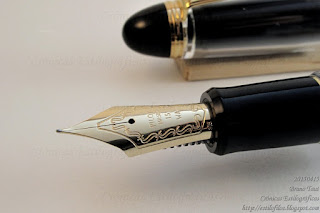The assumed knowledge was simple—by May of 1939, the Japanese government banned gold from all domestic industries. And this prohibition was only lifted in 1949 for export goods and in 1954 for the domestic market.
But then reality –like the fossil record— hit hard.
A distant friend showed the following pen in a forum:
It is a well known model—a Pilot RT from 1938 made in celluloid. The T stands for teko, lever (filler).
Inside, an impressive size-6 nib made of 14 K gold.
And underneath, the manufacturing date: 1.42—January of 1942.
This simple piece of information pushes us into changing that assumed knowledge about golden nibs in Japan. Some sources close to Pilot company explain that this nib was made for export, and it is very rare. They also suggest it might be a replacement nib, as the R models usually implemented smaller units. However, this should be taken with a grain of salt—it is difficult to install a big nib on a small pen, and there were not that many models available at the time.
The conclusion, though, is a more basic and more general one: there were gold nibs in Japan in the 1940s. Probably very few, but some.
My thanks to Mr. Niikura, Mr. Sunami, and Mr. Zúñiga.
Pilot Custom 823, WA nib – Montblanc White Forest
Bruno Taut
Nakano, May 30th, 2015
etiquetas: Japón, Pilot
Bruno Taut
Nakano, May 30th, 2015
etiquetas: Japón, Pilot
















4 comments:
I'm not sure whether I'm more impressed by the nib size or by the fact that it was gold and made during the occupation. Well, probably both. Because I've tried to fit a #4 14K (datecode 56) onto a an exact model once (just different colour) and it simply would not fit. So this is just phenomenal.
If Pilot pens of the WWII-era were supposed to have "white" nibs, it follows that they had similar trim. Also of stainless, or nickel or rhodium or?
And, if Ariel's pen has a gold nib, it appears that it, too, has gold (real or GP or GF?) trim.
Tony: the occupation did not occur until after the war in the Pacific was ended, in late 1945. Or am I missing something?
I was not aware of the possibility the nib # 6 belonged to another pen, but when I presented the pen in a forum and Bruno Taut was surprised and by the size and by the code 1-42 in the back of the nib, then I started paying attention (I am not a Japanese pen collector but have some). I believe that if by any chance the nib and the feed do not correspond to the pen it would have not been so easy to take them apart to clean them, photograph them, put them back and write again without any problem.
Once I learned about the nib code in Pilot pens, I thought maybe it was mounted like that for a special gift, but that is of course pure speculation... and I must say the same idea about occupation Paul Bloch's expressed crossed my mind..
Thank you all for passing by and commenting.
This nib was made about one month after the Pearl Harbor attack, and Japan still thought the War could be won... The war ended in August 1945.
All the pens I have with "shiro" nibs I have are silver in trim. They do not seem to have any plating and the color is the natural of whatever the metal--steel, aluminum... But, needless to say, proving the non-existence of a green unicorn is not possible.
Thanks to you all.
BT
Post a Comment
Your comments are welcome and appreciated.